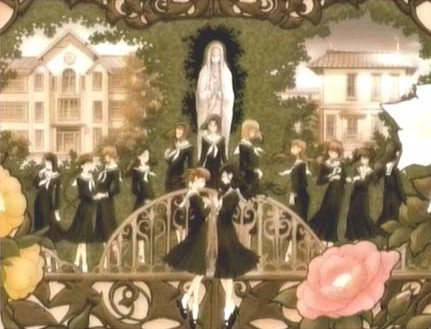The school idol taking a sudden interest in the everygirl for no reason anyone can understand is a common tropism in Japanese girls' school fiction - so common, in fact, that I can't think of a single girls' school shoujo-ai that doesn't use it. Sachiko and Yumi, Miya-sama and Nanako, all those girls from
Hana Monogatari... the list goes on. And now to it can be added Mabel and Aldred from
A Fourth Form Friendship, definitely the nicest Angela Brazil novel I've read yet.

The spirited Angela Brazil heroine au jour is Aldred, a fifteen-year-old with "charming gypsy looks" who has never attended a school before. She's absolutely determined to be the best in everything when she gets there - grades, sports, even popularity. But a spontaneous art lesson reveals that Aldred is all too quick to take credit for other's work, and let's just say that if that trait were a gun, it would be Chekhov's.
When she gets to the Grange she's not a little disappointed to learn that the girls don't find her absolutely enthralling. In fact, she has a little trouble making friendships at first. Then Mabel enters the picutre.
Mabel is the kind of idealized character that might make even Sachiko jealous. She's gorgeous, with waist-length, wavy red hair, fair skin, and light blue eyes. She comes from noble blood. She's inimitably good. And - and this is significant - although everyone likes her and she's kind to everyone, she never seems to want to make close friendships.
So it's hardly surprising that the Grange goes into a frenzy when Mabel suddenly approaches Aldred, asks her if she had stayed at a Seaforth during the summer, and from that point on is utterly inseparable from her.
At first it seems as though Mabel could fit right in with the perfect and incomprehensible
oneesama of shoujo-ai, but in fact she does have a reason for her attraction to Aldred that isn't "because she's cute" or something - she believes that Aldred saved a boy from a fire at Seaforth. It turns out that a girl with a similar last name had done that there a few weeks before Aldred arrived, and as the story came down the grapevine to Mabel it somehow ended up with Aldred as the protagonist. Now, Aldred doesn't learn this until she overhears it when Mabel tells it to some girls as Aldred's hiding in a closet (she just kind of felt like going in there). But by then she's so fond of Mabel that she can hardly just walk out, tell the truth, and perhaps end their friendship. Instead she vows to clear up the understanding when Mabel brings it up to her herself. And when that time comes - well, what would you do?

The rest of the novel features Aldred getting into scores of nasty scrapes and silly mischief, with Mabel defending her all the while. By now most of the girls of the school have heard of her reputation from saving people from fires, but she nearly starts more than one fire herself.

I won't tell you how it all works out, but I will say that it's very exciting and not too didactic and that it ends with a kiss - a kiss of "complete reconciliation and forgiveness" that commences a friendship "founded at last upon the rock of self-sacrifice and mutual endeavour". Now if that doesn't beat all the cutesy "hontoni daisuki" and luminescent blushing of shoujo-ai, I don't know what does.



















